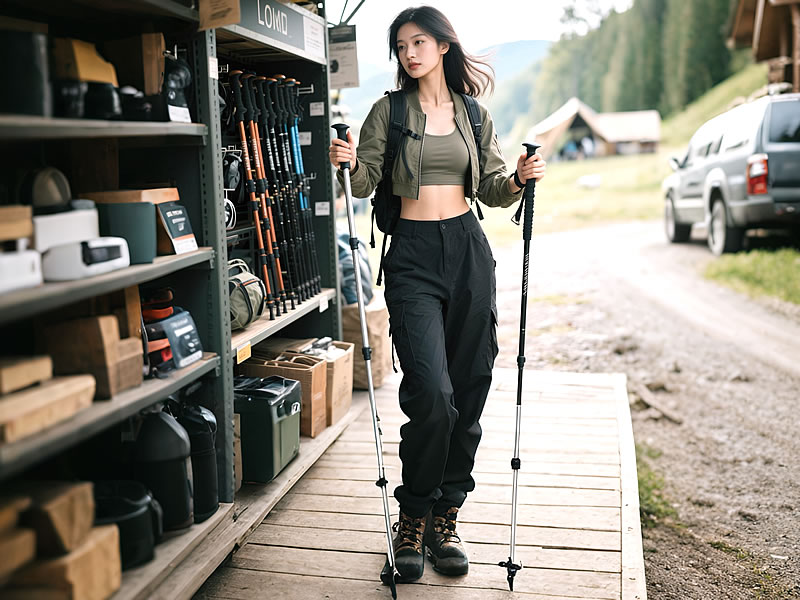Weight comparison: Grade aluminum vs carbon fiber trekking poles
When every ounce counts on the trail, the choice between aircraft-grade aluminum (7075-T6) and carbon fiber trekking poles hinges on a critical trade-off: absolute lightness versus impact survivability. Let’s dissect how these materials compare and where each excels.

⚖️ Weight Benchmarks: The Numbers
| Material | Avg. Weight per Pole | Weight Savings vs. Aluminum | Real-World Example |
|---|---|---|---|
| Carbon Fiber | 150–220g | 20–30% lighter | LEKI Black Series (195g) |
| Aircraft Aluminum (7075) | 230–280g | Baseline | Black Diamond Trail Pro (265g) |
Note: Weights vary by pole length, grip material, and locking mechanism.
Why 30% Matters:
Saving 70g per pole = 140g total (≈5 oz). For a 2,000-step mile:
- Carbon fiber: Burns 3–5% less energy (per University of Colorado biomechanics study)
- Aluminum: Extra weight compounds fatigue on 15+ mile days
💥 The Durability Divide: When Lightness Fails
| Failure Mode | Carbon Fiber | Aircraft Aluminum (7075) |
|---|---|---|
| Rock Strike | May shatter laterally | Dents but holds shape |
| Crush Impact | Catastrophic failure (e.g., trapped in door) | Minor bend, often field-repairable |
| Cold Exposure | Brittle below -20°C | Unaffected |
| UV Degradation | Resin weakens after 500+ sun hours | None |
| Fatigue Life | 1M+ cycles (if undamaged) | 500K+ cycles |
Real-World Data:
- Carbon failure rate: 8–12% on rocky trails (per 2023 Appalachian Trail gear survey)
- Aluminum failure rate: <4% in same conditions
📊 Performance Spectrum: Where Each Material Wins
Choose Carbon Fiber If You:
- Prioritize ultralight setups (base weight <10kg)
- Hike mostly non-technical terrain (e.g., Pacific Crest Trail sections)
- Value vibration damping (carbon absorbs 15–20% more shock)
- Top Picks: Gossamer Gear LT5 (165g), Z-Packs Carbon (172g)
Choose Aircraft Aluminum If You:
- Tackle scree/rock scrambles (e.g., Grand Canyon, Alps)
- Use poles for tarp setups or heavy loads (>25kg)
- Need all-season reliability (ice, rock impacts, sub-zero temps)
- Top Picks: Black Diamond Distance Carbon Z (hybrid), REI Co-op Flash (7075)
🔬 Hidden Weight Factors Most Miss
- Grip/Lock Weight: Cork grips add 15–20g vs. foam; flip locks weigh 10g more than twist locks
- Shaft Thickness: Aluminum requires 30% thicker walls for equal strength → weight penalty
- Hybrid Designs: Some poles (e.g., Komperdell C3) blend carbon upper sections with aluminum tips → best of both worlds
💰 Cost vs. Longevity Analysis
| Carbon Fiber | Aircraft Aluminum | |
|---|---|---|
| Avg. Price | $120–$220 | $80–$160 |
| Typical Lifespan | 3–5 years (with care) | 7–10+ years |
| Replacement Cost | $100+ per pole | $40–$80 per pole |
Ultralight math: Carbon saves ~140g but costs 2x more upfront with higher replacement risk.
⚠️ Critical Limitations to Consider
Carbon’s Dealbreakers:
- No warning before failure: Snaps suddenly when compromised
- Poor load versatility: Avoid using as tent poles or heavy load-bearing
- Cold fragility: Hazardous for winter mountaineering
Aluminum’s Drawbacks:
- Vibration transfer: More "buzz" in hands on rocky descents
- Corrosion risk: Requires rinsing after saltwater exposure
- Weight ceiling: Can’t compete with carbon’s lightest models
🧪 Lab vs. Trail: What Manufacturers Won’t Say
- Carbon "grades" vary wildly: Cheap "T300" carbon fails at 700 MPa stress; premium "T1000" handles 1,000 MPa. Always ask for modulus specs!
- 7075 isn’t indestructible: Thin-wall designs can bend under extreme side loads.
- Anodizing matters: Type III hard anodizing adds 0.05mm thickness but boosts aluminum’s scratch resistance 5x.
🏔️ Expert Recommendations by Use Case
| Scenario | Ideal Material | Why |
|---|---|---|
| Thru-hiking (well-maintained trails) | Carbon fiber | Weight savings justify risk |
| Off-trail/scree hiking | Aircraft aluminum | Survives rock strikes |
| Winter mountaineering | Aluminum | No cold brittleness |
| Ultralight fastpacking | Premium carbon | Sub-200g critical for speed |
| Budget-conscious hiking | 7075 aluminum | Durability > marginal weight save |
The Verdict
Carbon fiber reigns for pure weight savings (20–30% lighter) and vibration damping on groomed trails. Aircraft-grade aluminum (7075-T6) delivers unmatched impact resilience for technical terrain at a moderate weight penalty. For most hikers beyond ultralight disciplines, aluminum’s durability provides better long-term value. Hybrid designs offer a smart middle ground—but scrutinize carbon quality claims rigorously.
Pro Tip: Squeeze carbon poles before buying. High-end models feel uniformly stiff; cheap ones reveal soft spots or uneven resin.






